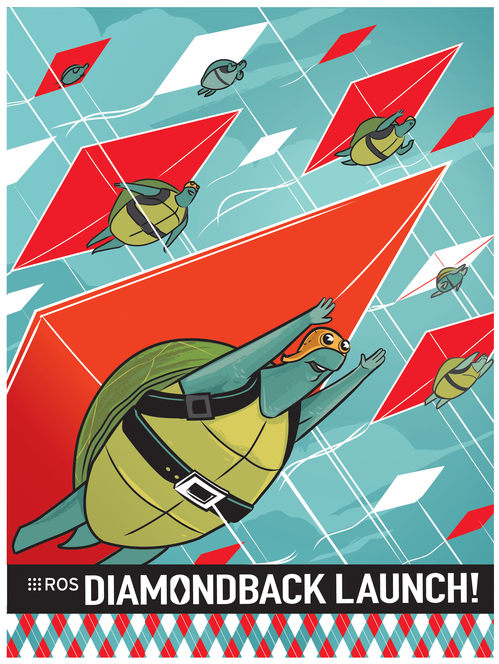ROS Diamondback has been released! This newest distribution of ROS gives you more drivers, more libraries, and more 3D processing. We've also worked on making it lighter and more configurable to help you use ROS on smaller platforms.
ROS 3D
The Kinect is a game-changer for robotics and is used on ROS robots around the world. ROS is now integrated with OpenNI Kinect/PrimeSense drivers and the Point Cloud Library (PCL) 3D-processing library has a new stable release for Diamondback. The ROS 3D contest entries showed the many creative ways you can integrate the Kinect with your robot, and we will continue to work on making the Kinect easier to use with ROS. We've also redone our C++ APIs to make OpenCV easier-to-use in ROS.
A Growing Community, More Robots
Diamondback is the first ROS distribution release to launch with stacks from the broader ROS community. Thank you to contributors from UT Austin, Uni Freiburg, Bosch, ETH Zurich, KU Leuven, UMD, Care-O-bot, TUM, University of Arizona and CCNY for making their drivers, libraries, and tools available. Many more robots are easier-to-use with ROS thanks to their efforts.
Now that there are over 50 different robots able to use ROS -- mobile manipulators, UAVs, AUVs, and more -- we are providing robot-specific portals to give you the best possible "out of the box" experience. If you have a Roomba, Nao, Care-O-bot, Lego NXT robot, Erratic, miabotPro, or PR2, there are now central pages to help you install and get the most out of ROS. Look for more robots in the coming weeks and months to be added to that list.
Smaller, lighter
We've reorganized ROS itself and broken it into four separate pieces: "ros", "ros_comm", "rx", and "documentation". This enables you to use ROS in both GUI and GUI-less configuration, which will enable you to install ROS on your robot with much smaller footprint. This separation will also assist with porting ROS to other platforms and integrating the ROS packaging system with non-ROS communication frameworks. For more details, see REP 100.
More open
Since ROS C Turtle, we've adopted a new ROS Enhancement Proposal (REP) process to make it easier for you to propose changes to ROS. We have also transitioned ownership of the ROS camera drivers to Jack O'Quin at UT Austin and look forward to enabling more people in the outside community to have greater ownership over the key libraries and tools in ROS. Please see our handoff list to find ways to become more involved as a contributor.
Answers
We launched the ROS Answers several weeks ago to make it easier for you to get in touch with a community of ROS experts. It is quickly becoming the best knowledge base on ROS with over 200 questions in a wide variety of topics.
Other highlights
For more information, please see the Diamondback release notes. Some of the additional highlights include:
- Eigen 3 support, with compatibility for Eigen 2.
- camera1394 now supports nodelets and has been relicensed as LGPL.
- rosjava has been updated and is now maintained by Lorenz Moesenlechner of TUM.
- bond makes it easier to let two ROS nodes monitor each other for termination.
- rosh is a new experimental Python scripting environment for ROS.
- New nodelet-based topic tools
- PointCloud2 support in the ROS navigation stack.
Thanks
From the numerous contributed stacks to patches to bug reports, this release would not have been possible without the help of the ROS community. In particular, we appreciate your help testing and improving the software and documentation for the Diamondback release candidates to make this the best release possible. We hope that Diamondback helps you get more done with your robots, and we look forward to your contributions in future releases.








Leave a comment